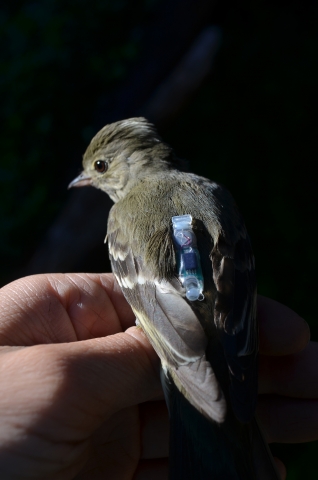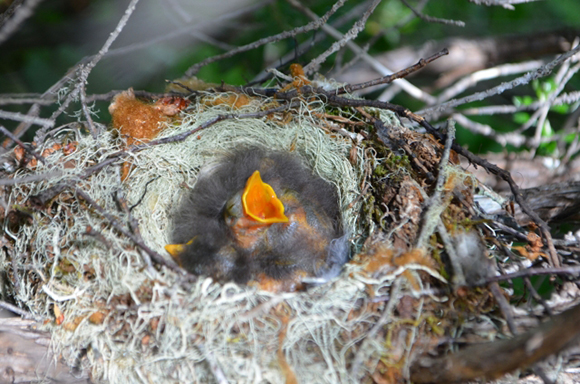Rocio Jara
Doctoral student in Biological Science at University of North Texas

The main aim of my research is to study the migration phenology and ecology of the poorly understood White-crested Elaenia (Elaenia albiceps) population that reproduces on Navarino Island (55°S). During the reproductive season of 2014 I started data collection to 1) determine timing, migration pathways, stopover locations, and wintering grounds of the White-Crested Elaenia and 2) describe White-crested Elaenia microhabitat selection for nesting. We deployed 54 light-level geolocators (Intigeo P55B1-7, Migrate Techonology, Ltd, Coton, Cambridge, UK) to adult White-crested Elaenia that showed signs of being reproducing or attempting to and to individuals that were recaptured. These geolocators need to be recovered (i.e. recapture of individuals) during the next reproductive season. In addition, we recovered one geolocator that was deployed in a previous year.
We located and monitored 7 White-crested Elaenia nests. In addition to visit the nests almost every day, we installed camera traps in front of them to determine causes of failure, if applicable. Of the 7 nests, we located 1, 4, and 2 during laying, incubation, and nestling periods, respectively. The earliest incubating nest was located on November 28, 2014 and the latest on January 4, 2015. The incubation period lasts 15 days and the average clutch size is 2.3 eggs. The nestling period lasts 14 days. Of the 7 nests, 3 were successful and 4 failed (2 depredated, and 2 abandoned). Of the depredated nests, in one case the camera captured a Chimango Caracara (Milvago chimango) depredating it. In the other case the camera did not capture the predator. It is possible that this nest was preyed upon by an American mink (Neovison vison) as it was placed on a fallen tree, 85 cm from the ground, connected to the ground through big logs easily accessible, but most importantly, one of the volunteers saw a mink in this area (10 m from the nest) some days before this nest was depredated. In addition, we captured images of a mink preying on a nest of a different species Patagonian Sierra Finch (Phrygilus patagonicus) in the same area 3 weeks earlier.

The nests were placed, on average, at 110 cm from the ground (min = 52 cm, max = 360 cm), in a variety of plant/tree species including Antarctic Beech (Nothofagus antarctica), Magellan's beech (Nothofagus betuloides), Escallonia virgata, Magellan Barberry (Berberis buxifolia), Winter's Bark (Drimys winteri) and Chilean Firebush (Embothrium coccineum). The height of the shrub/tree species ranged from 1.4 m to 6.9 m (mean = 3.3 m). They used live, partially dead, and dead substrates. In the case of partially dead trees, they always used the dead portion to place their nest. The nests always had a high percentage of overhead cover (70-100%) measured from 1 m above the nest. Likewise, concealment from at least 3 cardinal points was usually high. However, in two nests, the percentage of side cover from two points was 0. Coincidently, these were the two nests that were depredated. Regarding the shape and composition of the nests, these are open cup of dried grass, twigs, mosses, and considerable amount of the lichen Protousnea magellanica. The average external diameter was 10.1 cm, internal diameter 4.9 cm, height 6.6 cm, and depth 3.3 cm.

During the next field season (October 2015- February 2016) I will attempt to recapture geolocators and continue the study on reproductive ecology of the White-crested Elaenia, as well as collecting other type of data to answer new questions. The new question involves aspects of the immune system function of this species and how it is affected by its long migration.